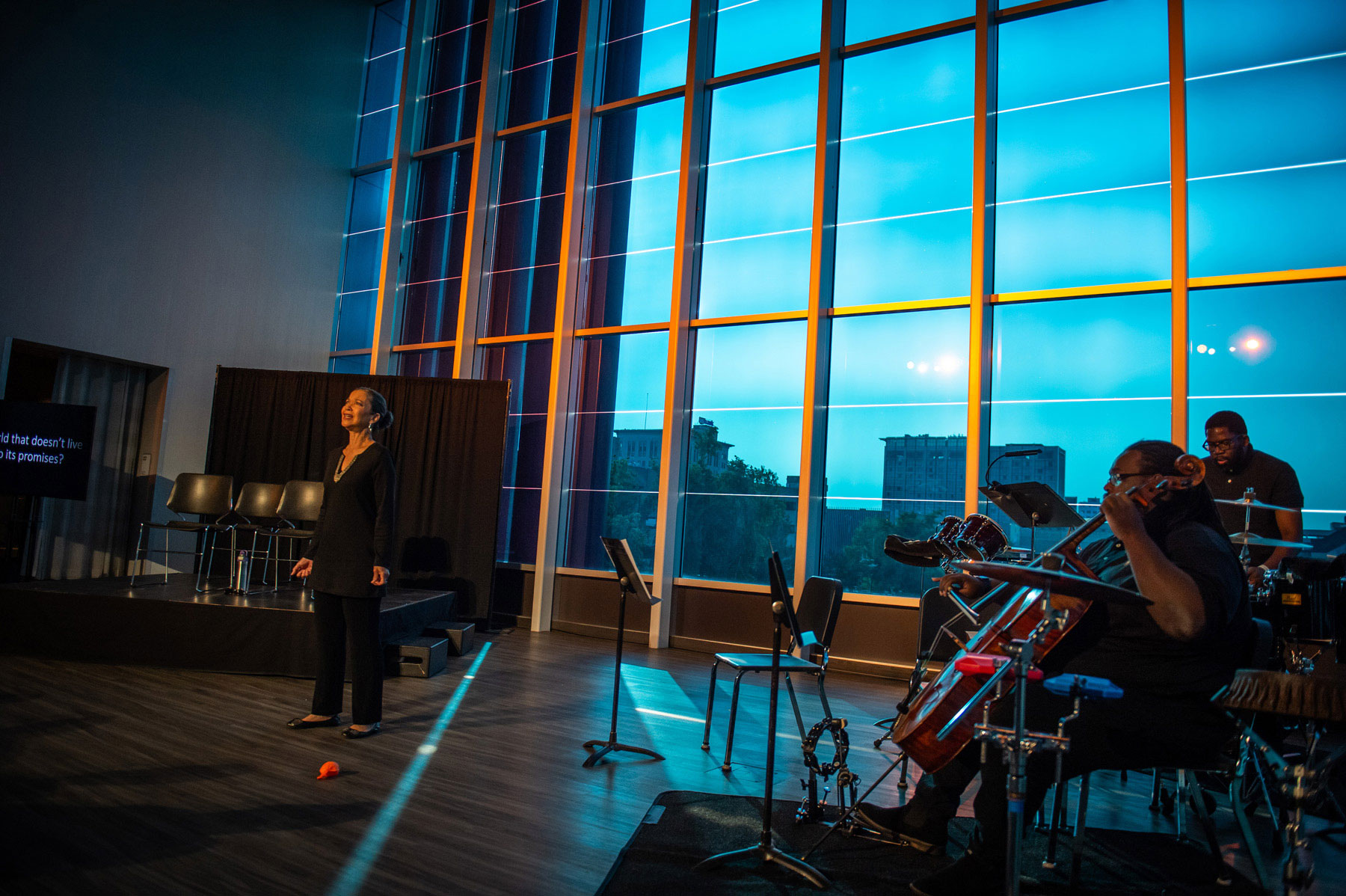“Every time you leave, I’ll try to let go a little more. But every time, I’ll be waiting to hear your key in our front door.” – The Mother in dwb (driving while black)
So concludes composer Susan Kander and librettist Roberta Gumbel’s trim, crackling 45-minute opera about an African American mom’s gnawing fear that her son, armed with nothing more than his first driver’s license at sixteen, could become an especial target for unwarranted violence, owing to his race.
The musical and dramatic structure defines the phrase “lean and mean.” Or perhaps, rather, “lean and fraught with meaning.” It is tempting to call it a monodrama, since it features one real named character, Mother. But really, it is a trio since the cellist and percussionist are non-named characters in their own right.
The basic through line is Mother’s loving relationship with her young son, from her doting on him as a baby, through terrible twos, growing pains, school days, and budding adulthood. Ms. Gumbel’s revelatory libretto charts this developing relationship with witty observation and fosters our belief that the two have forged a deep and abiding bond, even though we never see the boy in their conversations.
This outer narrative story is frequently interrupted by a stream of inner consciousness, parenthetical quotes that are ripped from the headlines. We know them all too well. The plight of Trayvon Martin, George Floyd, Tyre Nichols. . .need I go on? This juxtaposition of documented disproportionate incidents involving African-American victims chillingly underscores Mother’s fear for her son. Sadly, it is not unfounded.

Roberta Gumbel has not only crafted a compelling dramatic presentation, but she also performs the role of Mother with unbridled skill and barely controlled passion. Ms. Gumbel’s seasoned, sizable lyric soprano can soar and dip, whisper and scream, croon and command with accomplished ease. She knows how to land every moment and nail it she does, with pathos and humanity.
The musical writing is unlike anything you have probably heard. Composer Susan Kander has scored it for soprano, cello, and percussion, but writing those three words does not come anywhere near to describing the variety and profusion of layered effects she masterfully unleashes. Cellist Cremaine Booker and percussionist David Leon Verin are Herculean in meeting the myriad demands of Ms. Kander’s kaleidoscopic soundscape. They actually serve as a chorus, that helps narrate the action and move it forward.
In addition to what you might “usually” expect from these two instrumentalists, they are called upon to clap, activate a tambourine or bass drum with a foot, tap the body of the cello with the hand, release a deflating balloon, punch a tone cluster on a toy piano, slap their bodies, rap sticks together, snap their fingers, and occasionally, speak or sing. These numerous unsettling and stinging effects are what you might expect in a scary movie.
One harrowing musical and dramatic moment that has haunted me ever since was when we were told a young man had been severely beaten. The two musicians, in silent unison, raised bows in the air and brought them down again and again in swooshing unison. My mind and heart filled in the brutal sound of clubs meeting their mark. Horrifying.
I was reminded of similar non-traditional musical effects that characterized Karlheinz Stockhausen’s Momentethat I saw on PBS lo those many teenage years ago. Although Ms. Kander’s creation is a small fraction of that sized opus, it is no less startling, fresh, and daring. While dwb is atonal overall, there are mere flashes of “usual” harmonies and tunes here and there, that land like emotional lightning bolts for their sudden familiarity. This skillful wedding of music and text was at once highly satisfying, profoundly moving, and relentlessly thought-provoking.
Director Chip Miller has kept the staging simple, clean, and focused. There is a low platform stage right that contains four black and chrome chairs that suggest the car, with the large bank of percussion up stage left, fronted by the cellist and his extra accoutrements. While the blocking was straightforward, Mr. Miller injected variety of positioning, not easy to do when there is really only one character to position! It’s relative stillness was arguably a great strength, allowing the work (and Ms. Gumbel’s internalization of the role) to speak for itself.
I caught the performance in Grand View University’s Viking Theatre, a beautiful thrust stage, with the playing area situated so the audience sits on three sides. This was a touring performance that was playing the last of its run here, and it was clearly staged as a straight front proscenium presentation. While I understand why it was similarly presented that way on this occasion, it would have been enhanced even further by tweaking it just a bit to acknowledge the layout.
Performances were followed by lively panel discussions and observations that were co-sponsored by Humanities Iowa.
This piece was a bold choice in a state where the population is 90% white, and the nearly sold out audience seemed an even higher percentage. DMMO is to be applauded for advocating for social justice, and staging this piece coupled with the post-show exchange to allow it to instruct and inform, without scolding or shaming.
Those in attendance were clearly moved to listen and ponder an absorbing message, to strive to understand and, dare I say, hope. It was heartening indeed to think that many are willing to listen, learn, and perhaps together, create a better world.
James Sohre
dwb (driving while black)
Music by Susan Kander
Libretto by Roberta Gumbel
Mother: Roberta Gumbel; Director: Chip Miller; Cello: Cremaine Booker; Percussion: David Leon Verin
Top Image: Roberta Gumbel as the Mother.
All photos by Luke Behaunek courtesy of Des Moines Metro Opera